Invasive lobular carcinoma is a type of breast cancer that begins in the milk-producing glands (lobules) of the breast.
Invasive cancer means the cancer cells have broken out of the lobule where they began and have the potential to spread to the lymph nodes and other areas of the body.
Invasive lobular carcinoma makes up a small portion of all breast cancers. The most common type of breast cancer begins in the breast ducts (invasive ductal carcinoma).
Symptoms
At its earliest stages, invasive lobular carcinoma may cause no signs and symptoms. As it grows larger, invasive lobular carcinoma may cause:
- An area of thickening in part of the breast
- A new area of fullness or swelling in the breast
- A change in the texture or appearance of the skin over the breast, such as dimpling or thickening
- A newly inverted nipple
Invasive lobular carcinoma is less likely than other forms of breast cancer to cause a firm or distinct breast lump.
When to see a doctor
Make an appointment with your doctor if you have any signs or symptoms that worry you. Your doctor will perform an examination and determine whether you need a diagnostic breast X-ray (mammogram) or a breast ultrasound.
Ask your doctor when to begin screening tests for breast cancer to help detect cancer early and before you may have any signs or symptoms. Routine screening tests may include a physical exam and a mammogram.
Various organizations differ on their screening recommendations, but many suggest women with an average risk of breast cancer consider beginning mammograms in their 40s.
If you have a family history of breast cancer or other factors that increase your risk of breast cancer, your doctor may recommend beginning screening mammograms or other tests at an earlier age.
Causes
It's not clear what causes invasive lobular carcinoma.
Doctors know that invasive lobular carcinoma begins when cells in one or more milk-producing glands of the breast develop mutations in their DNA. The mutations lead to the inability to control cell growth, which results in the cells dividing and growing rapidly. Depending on the aggressiveness of the cancer type, the cancer cells can spread to other parts of the body.
Lobular carcinoma cells tend to invade breast tissue by spreading out in a distinct way rather than forming a firm nodule. The affected area may have a different feel from the surrounding breast tissue, more like a thickening and fullness, but it's unlikely to feel like a lump.
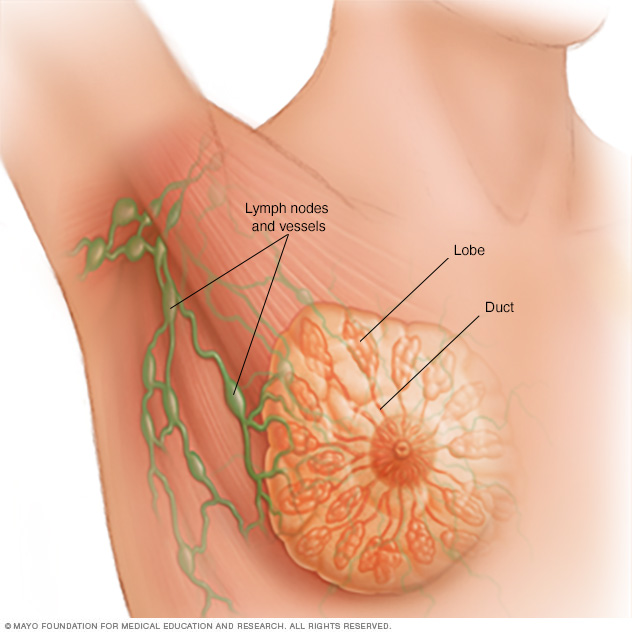
Each breast contains 15 to 20 lobes of glandular tissue, arranged like the petals of a daisy. The lobes are further divided into smaller lobules that produce milk for breastfeeding. Small tubes (ducts) conduct the milk to a reservoir that lies just beneath your nipple.
Risk factors
Factors that may increase your risk of invasive lobular carcinoma include:
- Being female. Women are more likely to develop breast cancer, but men also can develop breast cancer.
- Older age. Your risk of breast cancer increases as you age. Women with invasive lobular carcinoma tend to be a few years older than women diagnosed with other types of breast cancer.
- Lobular carcinoma in situ (LCIS). If you've been diagnosed with LCIS — abnormal cells confined within breast lobules — your risk of developing invasive cancer in either breast is increased. LCIS isn't cancer, but is an indication of increased risk of breast cancer of any type.
- Postmenopausal hormone use. Use of the female hormones estrogen and progesterone during and after menopause has been shown to increase the risk of invasive lobular carcinoma.
-
Inherited genetic cancer syndromes. Women with a rare inherited condition called hereditary diffuse gastric cancer syndrome have an increased risk of both stomach (gastric) cancer and invasive lobular carcinoma.
Women with certain inherited genes may have an increased risk of breast and ovarian cancers.
Prevention
To reduce your risk of breast cancer, consider trying to:
-
Discuss the benefits and risks of menopausal hormone therapy with your doctor. Combination hormone therapy may increase the risk of breast cancer.
Some women experience bothersome signs and symptoms during menopause and, for these women, the increased risk of breast cancer may be acceptable in order to relieve menopause signs and symptoms.
To reduce the risk of breast cancer, use the lowest dose of hormone therapy possible for the shortest amount of time.
- Drink alcohol in moderation, if at all. If you choose to drink alcohol, do so in moderation. For healthy adults, that means up to one drink a day for women of all ages and men older than age 65, and up to two drinks a day for men age 65 and younger.
- Exercise most days of the week. Aim for at least 30 minutes of exercise on most days of the week. If you haven't been active lately, ask your doctor whether exercise is OK and then start slowly.
-
Maintain a healthy weight. If your current weight is healthy, work to maintain that weight.
If you need to lose weight, ask your doctor about healthy weight-loss strategies. Reduce the number of calories you eat each day and slowly increase the amount of exercise. Aim to lose weight slowly — about 1 or 2 pounds a week.
If you have a family history of breast cancer or feel you may have an increased risk of breast cancer, discuss it with your health care provider. Preventive medications, surgery and more-frequent screening may be options for women with a high risk of breast cancer.
Diagnosis
Diagnosing invasive lobular carcinoma
Tests and procedures used to diagnose invasive lobular carcinoma include:
- Mammogram. A mammogram creates an X-ray image of your breast. Invasive lobular carcinoma is less likely to be detected on a mammogram than other types of breast cancer are. Still, a mammogram is a useful diagnostic test.
- Ultrasound. Ultrasound uses sound waves to create pictures of your breast. Invasive lobular carcinoma may be more difficult to detect with ultrasound than may other types of breast cancer.
- Magnetic resonance imaging (MRI). MRI uses a strong magnetic field to create a picture of your breast. Breast MRI may help in evaluating an area of concern when mammogram and ultrasound results are inconclusive. It can also help determine the extent of the cancer within your breast.
-
Removing a sample of tissue for testing (biopsy). If an abnormality is detected, your doctor may recommend a biopsy procedure to remove a sample of suspicious breast tissue for laboratory testing.
A breast biopsy can be done using a needle to draw out fluid or tissue from the breast, or breast tissue can be removed surgically.
Determining the extent of invasive lobular carcinoma
Once it's determined that you have invasive lobular carcinoma, your doctor will determine if additional tests are needed to learn the extent (stage) of your cancer. Most women do not require additional tests other than breast imaging, physical exam and blood tests.
Using this information, your doctor assigns your cancer a Roman numeral that indicates its stage. Breast cancer stages range from 0 to IV, with 0 indicating cancer that is very small and noninvasive. Stage IV breast cancer, also called metastatic breast cancer, is cancer that has spread to other areas of the body.
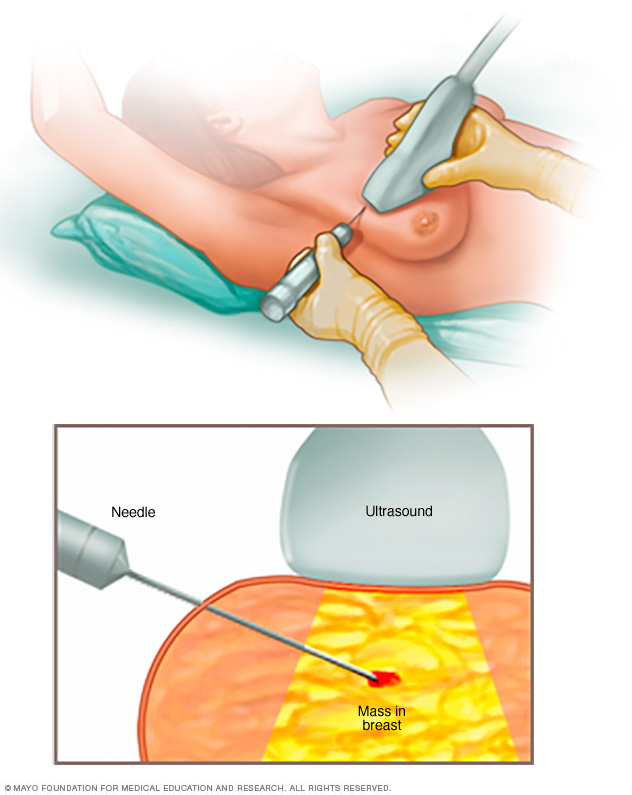
A core needle biopsy uses a long, hollow tube to obtain a sample of tissue. Here, a biopsy of a suspicious breast lump is being done. The sample is sent to a lab for testing and evaluation by doctors, called pathologists. They specialize in analyzing blood and body tissue.
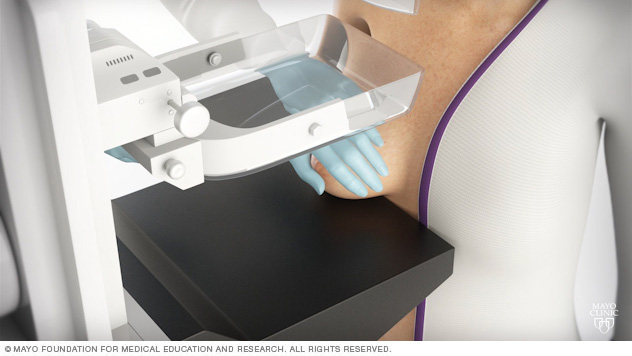
During a mammogram, you stand in front of an X-ray machine designed for mammography. A technician places your breast on a platform and positions the platform to match your height. The technician helps you position your head, arms and torso to allow an unobstructed view of your breast.
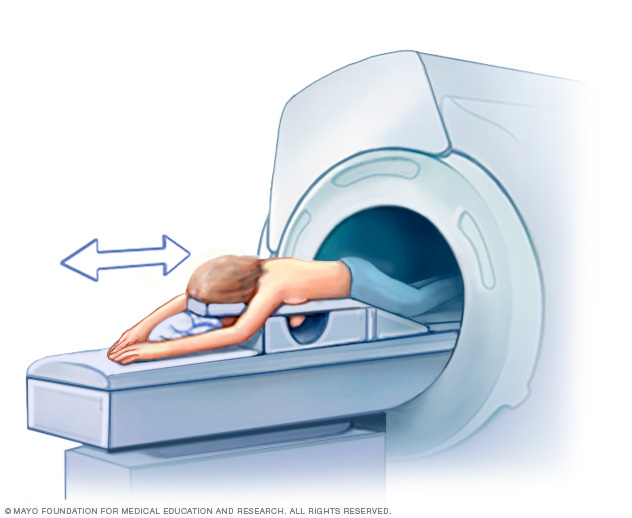
During a breast MRI, you lie on your stomach on a padded scanning table. Your breasts fit into a hollow depression in the table, which contains coils that detect magnetic signals. The table slides into the large opening of the MRI machine.
Treatment
Your treatment options for invasive lobular carcinoma depend on the aggressiveness of your cancer, its stage, your overall health and your preferences. Treatment often consists of surgery and additional (adjuvant) therapy, which may include chemotherapy, radiation and hormone therapy.
Surgery
Surgery for invasive lobular carcinoma may include:
-
Removing the cancer and a small portion of healthy tissue. Called a lumpectomy (wide local excision), this procedure allows you to keep most of your breast tissue.
The surgeon removes the tumor itself, as well as a margin of normal tissue surrounding the tumor to make sure all the cancer that can be removed is taken out.
If the tissue around the tumor shows signs of cancer cells (positive margins), you may need additional surgery until negative margins are achieved. In some cases, this may mean removing all of the breast tissue.
- Removing all of the breast tissue. Mastectomy is an operation to remove all of your breast tissue. During a total (simple) mastectomy the surgeon removes all of the breast tissue — the lobules, ducts, fatty tissue and skin, including the nipple and areola. Some other types of mastectomy may leave the skin or the nipple in place and may be options based on your specific situation.
-
Sentinel lymph node biopsy. To determine whether cancer has spread to the lymph nodes near your breast, your surgeon identifies the first few lymph nodes that receive the lymph drainage from your cancer. These lymph nodes are removed and tested for breast cancer cells (sentinel node biopsy).
If no cancer is found, the chance of finding cancer in any of the remaining nodes is small and no other nodes need to be removed.
Axillary lymph node dissection. If cancer is found in the sentinel node, then your surgeon may remove additional lymph nodes in your armpit (axillary lymph node dissection).
Knowing if cancer has spread to the lymph nodes helps determine the best course of treatment, including whether you'll need chemotherapy or radiation therapy.
Hormone therapy
Hormone therapy — perhaps more properly termed hormone-blocking therapy — is often used to treat breast cancers that are sensitive to hormones. Most invasive lobular carcinomas are hormone receptor positive, meaning they use hormones to grow.
To decrease the chance of your cancer returning, hormone therapy can be used before or after surgery or other treatments. If the cancer has already spread, hormone therapy may shrink and control it.
Treatments that can be used in hormone therapy include:
- Medications that block hormones from attaching to cancer cells (selective estrogen receptor modulators)
- Medications that stop the body from making estrogen after menopause (aromatase inhibitors)
- Surgery or medications to stop hormone production in the ovaries
Radiation therapy
Radiation therapy uses high-powered energy, such as X-rays and protons, to kill cancer cells.
During radiation therapy, you lie on a table while a large machine moves around you, directing energy beams at precise points in your breast.
Radiation therapy may be recommended after a lumpectomy. It may also be recommended after a mastectomy if your cancer was large or involved the lymph nodes.
Chemotherapy
Chemotherapy uses drugs to kill cancer cells. Treatment often involves receiving two or more drugs in different combinations.
Chemotherapy can be given through a vein, in pill form or both ways.
Chemotherapy may be recommended after surgery to kill any cells that may remain.
Chemotherapy can also be used before surgery to shrink a tumor that is large. For women with larger tumors, chemotherapy before surgery may make it possible to choose lumpectomy over mastectomy.
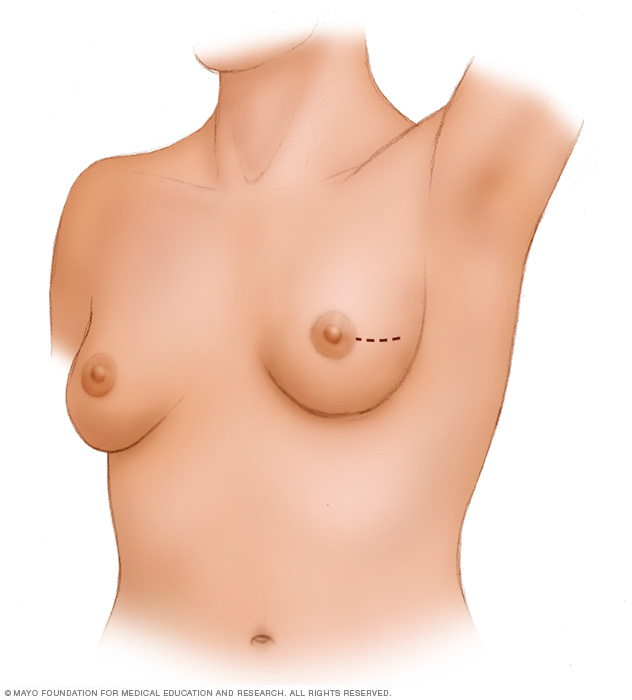
A lumpectomy involves removing the cancer and some of the healthy tissue that surrounds it. This illustration shows one possible incision that can be used for this procedure, though your surgeon will determine the approach that's best for your particular situation.
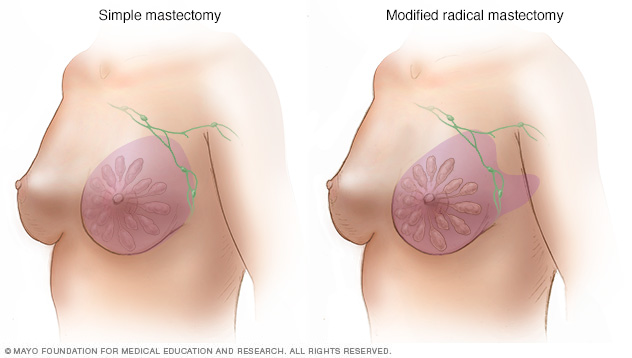
A simple mastectomy (left) removes the breast tissue, nipple, areola and skin but not all the lymph nodes. A modified radical mastectomy (right) removes the entire breast — including the breast tissue, skin, areola and nipple — and most of the underarm (axillary) lymph nodes.
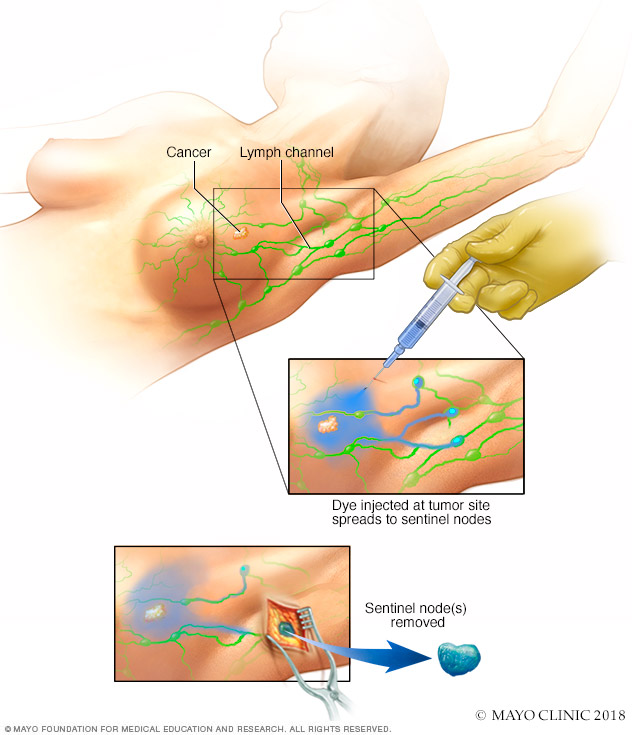
Sentinel node biopsy identifies the first few lymph nodes into which a tumor drains. The surgeon uses a harmless dye and a weak radioactive solution to locate the sentinel nodes. The nodes are removed and tested for signs of cancer.
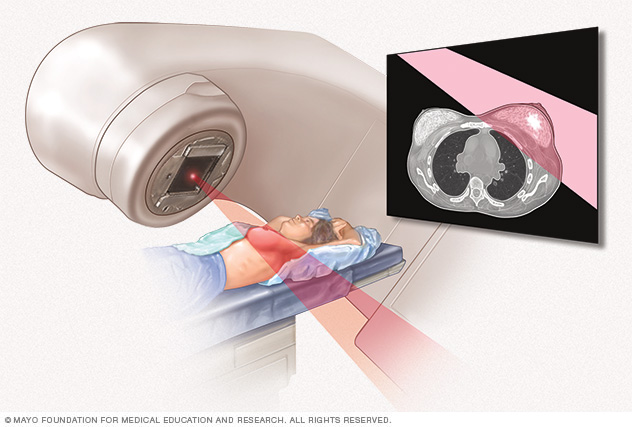
External beam radiation uses high-powered beams of energy to kill cancer cells. Beams of radiation are precisely aimed at the cancer using a machine that moves around your body.
Alternative medicine
No alternative medicine treatments can cure breast cancer. Instead, complementary and alternative treatments are most helpful for coping with the side effects of cancer and cancer treatment, such as hot flashes.
Alternative treatments for hot flashes
Hot flashes — bouts of sudden, intense warmness that can leave you sweaty and uncomfortable — can be a symptom of natural menopause or a side effect of hormone therapy for breast cancer.
Women with breast cancers that use hormones to grow may receive hormone therapy to block the interaction between hormones and cancer cells. Most invasive lobular carcinomas are hormone receptor positive.
Talk to your doctor if you experience hot flashes. If hot flashes are mild, they're likely to subside over time. In most women, hot flashes eventually disappear. However, some women experience severe and bothersome hot flashes. Many conventional treatments are available for hot flashes, including medications.
If treatment for hot flashes won't work as well as you'd like, it might help to add complementary and alternative treatments to make you feel better.
Options might include:
- Acupuncture
- Hypnosis
- Meditation
- Relaxation techniques
- Tai chi
- Yoga
While none of these alternative treatments is proved to help control hot flashes, some preliminary evidence shows that some breast cancer survivors find them helpful.
If you're interested in trying alternative treatment for hot flashes, talk to your doctor about your options.
Coping and support
A diagnosis of breast cancer may be one of the most difficult situations you'll ever face. It can make you feel emotions ranging from shock and fear to anger, anxiety or depression.
There's no "right" way to feel and act when you're dealing with cancer. With time, you'll find your own way of coping with your feelings. Until then, you may find comfort if you:
-
Learn enough about your cancer to make treatment decisions. Ask your doctor for details about your cancer — the type, stage and treatment options. The more you know, the more comfortable you may feel when making treatment decisions.
Ask your doctor to recommend good sources of information where you can learn more. Good places to start include the National Cancer Institute and the American Cancer Society.
-
Seek support from family and friends. Your close friends and family can provide a support system that can help you cope during treatment.
They can help you with the small tasks around the house that you may not have the energy for during treatment. And they can be there to listen when you need to talk with someone.
-
Connect with other people with cancer. Other people with cancer can offer unique support and insight because they understand what you're experiencing. Connect with others through support groups in your community.
Ask your doctor about support groups or contact your local chapter of the American Cancer Society. Online support groups also are available at sites such as Breastcancer.org.
-
Take care of yourself. During your treatment, allow yourself time to rest.
Take good care of your body by getting enough sleep so that you wake feeling rested, choosing a diet full of fruits and vegetables, staying as physically active as you're able, and taking time to relax.
Try to maintain at least some of your daily routine, including social activities.
Preparing for an appointment
Start by making an appointment with your family doctor if you have any signs or symptoms that worry you.
If your doctor finds cancer from a biopsy performed on the area of concern, you may be referred to a doctor who specializes in treating cancer (oncologist).
Because appointments can be brief, and because there's often a lot to discuss, it's a good idea to be well-prepared. Here's some information to help you get ready, and what to expect from your doctor.
What you can do
- Be aware of any pre-appointment restrictions. At the time you make the appointment, be sure to ask if there's anything you need to do in advance, such as restrict your diet.
- Write down any symptoms you're experiencing, including any that may seem unrelated to the reason for which you scheduled the appointment.
- Write down key personal information, including any major stresses or recent life changes.
- Make a list of all medications, vitamins or supplements that you're taking.
- Consider taking a family member or friend along. Sometimes it can be difficult to remember all the information provided during an appointment. Someone who accompanies you may remember something that you missed or forgot.
- Write down questions to ask your doctor.
Your time with your doctor is limited, so preparing a list of questions can help you make the most of your time together. List your questions from most important to least important in case time runs out.
For invasive lobular carcinoma, some basic questions to ask your doctor include:
- Do I have breast cancer?
- What is the size of my breast cancer?
- What is the stage of my breast cancer?
- Will I need additional tests?
- How will those tests help you determine the best treatments for me?
- What are the treatment options for my cancer?
- What are the side effects of each treatment option?
- How will each treatment option affect my daily life? Can I continue working?
- Is there one treatment you recommend over the others?
- How do you know that these treatments will benefit me?
- What would you recommend to a friend or family member in my situation?
- How quickly do I need to make a decision about cancer treatment?
- Does my insurance plan cover the tests and treatment you're recommending?
- Should I seek a second opinion? Will my insurance cover it?
- Are there any brochures or other printed material that I can take with me? What websites or books do you recommend?
In addition to the questions that you've prepared to ask your doctor, don't hesitate to ask other questions that occur to you.
What to expect from your doctor
Your doctor is likely to ask you a number of questions. Being ready to answer them may allow time later to cover other points you want to address. Your doctor may ask:
- When did you first begin experiencing symptoms?
- Have your symptoms been continuous or occasional?
- How severe are your symptoms?
- What, if anything, seems to improve your symptoms?
- What, if anything, appears to worsen your symptoms?
Copyright © 1998-2025 Mayo Foundation for Medical Education and Research (MFMER). All rights reserved.